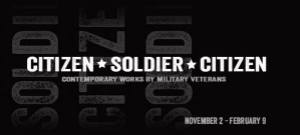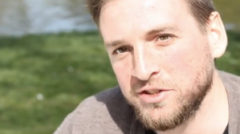This Land: A Compelling Story
By Katey Schultz
A little over a year ago, I was thrust into the veteran community whether I was ready for it or not. Sure, I’d spent the last three years of my life researching the wars in Iraq and Afghanistan to imagine stories for my debut collection, Flashes of War. But that was in the privacy of my own writing studio and the safe explorations of my own imagination. I’d never been in a room full of veterans. I’d never travelled to the Middle East. I’d never worn 55 pounds of battle rattle or ridden in a Humvee, let alone fired an M4 because my life (and my buddies’ lives) depended on it.
What I found was that my book was received by a group of polite, focused, inquisitive people. Those veterans who read my short stories had stories of their own—lived stories—but they still took the time to engage with me: the mild-mannered thirty-something white girl who wrote about combat she never saw. Whether at a book event, in the airport, waiting in line at the grocery store, or doing business, if someone was a veteran, they typically made themselves known. Because of all the time I’d spent looking closely at our most recent wars, for the first time in my life, our conversations had a shared starting point. More importantly, for the first time in my life, I actually had something to say back.

So when a new message from Dan McCready of THIS LAND showed up in my inbox, I wasn’t entirely unprepared. A former Marine and Harvard Business School graduate, he introduced himself as the founder of a small start-up company based in Charlotte, North Carolina that was committed to pioneering the American spirit. My attention caught. American spirit? Now that’s a tough thing to put your finger on. Yet as I clicked through the images of work by THIS LAND artists on the company website, I had to admit I could see it. Our American spirit; that thing that makes people living in America most essentially who they are, no matter their race, age, sexual orientation, level of education, or economic status. Then, I read Dan’s story as founder of THIS LAND and knew I wanted to assist his team as a writer.
In short, THIS LAND is an online company carrying a highly curated selection of handmade functional objects for everyday use and enjoyment. Plates, mugs, scarves, bottle openers, earrings, belt buckles, and linens—yes—but with the kind of quality and craftsmanship that represents the best of our country he fought to protect. Dan founded the company because he believes handmade objects in America are key to preserving and expanding our cultural heritage. “The corporate fast track was interesting work, but my heart wasn’t in it,” Dan recalls. “That experience motivated me to take a stab and do something on my own. Now, I can say I’m doing something that matters to me and makes a difference. That was something I missed from my days in the Marine Corps. I’m grateful I’ve found it again.”
That’s how a person can get from leading a platoon of 65 Marines in Ramadi, to promoting an artist who makes handblown glass flasks in the mountains of North Carolina. Regardless of politics, of wins and losses, or of achievements and regrets, after serving his country for four years, Dan somehow understood that the most meaningful way to “come home” would be to find something that represented the best of the country he stood up for and make it accessible to a wider audience.
The connection may sound subtle, but because of my background researching Flashes of War and looking for signs of veteran activity everywhere I went, to my ears it rings loud and clear. We can celebrate what’s quintessentially American by supporting American-made. We can revitalize the sense of individuality and creativity that our founding father’s had in mind by uplifting the self-supporting artists in our midst. We can connect with our shared history by using a forged steel letter opener we may someday pass on to our children. In short, we can pioneer the American spirit one beautiful object at a time—investing in tradition and creativity and our economy at the same time. It may sound like a pitch, but I’d argue it also sounds like the best news I’ve heard in a long time.
Working with a team of six (two of whom are veterans) in a small apartment, Dan started THIS LAND with the determination of a family man who wants to assure his children grow up in a country that still stands for something real. Last week, in a conversation with IAVA staff member Rebecca Forbes, Dan explained the rest of his mission. “In the bigger picture, I want THIS LAND to be a voice that adds to the dialogue about the spirit of this country…To that end, we use our company blog to explore this through a number of themes, including studio visits with our artists, but also our thoughts on pioneers, independence, family, war, tradition, and memory.” Just last month, THIS LAND team member Mel McCaslin, a pilot in the Navy Reserves, wrote about her hero Amelia Earhart in celebration of the anniversary of Earhart’s transatlantic flight.
For my part, it’s a way to connect the hard work of my fellow neighbors and community members in the North Carolina mountains I call home, with the dream of a veteran who has a background in business. As with the stories I worked so hard to imagine for Flashes of War, I can begin with two ideas that seem disparate and write my way toward hopeful understanding. I’d argue that both outlets—the fictional world of my short stories and the real world of Dan’s company carrying artwork that embodies the American spirit—work toward a way forward in what we hope to soon be a post-war era for our nation.

Katey Schultz is author of Flashes of War, 2013 winner of the Military Writers Society of America Gold Medal in Literary Fiction and an IndieFab Book of the Year from ForeWord Review. Learn more about her writing life at www.kateyschultz.com.




 To him, the work is calming and helps him escape. Passionate, he says, is an understatement. He’s found definitive purpose in creating his pieces. He is always thinking about the next project, new ideas, or ways to improve technique. It’s also a way to commemorate his brothers’ and sisters’ service, and to keep connected to the military world.
To him, the work is calming and helps him escape. Passionate, he says, is an understatement. He’s found definitive purpose in creating his pieces. He is always thinking about the next project, new ideas, or ways to improve technique. It’s also a way to commemorate his brothers’ and sisters’ service, and to keep connected to the military world.



